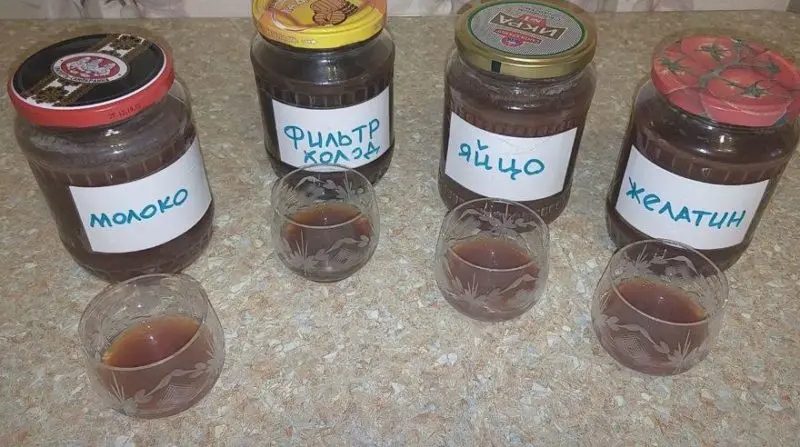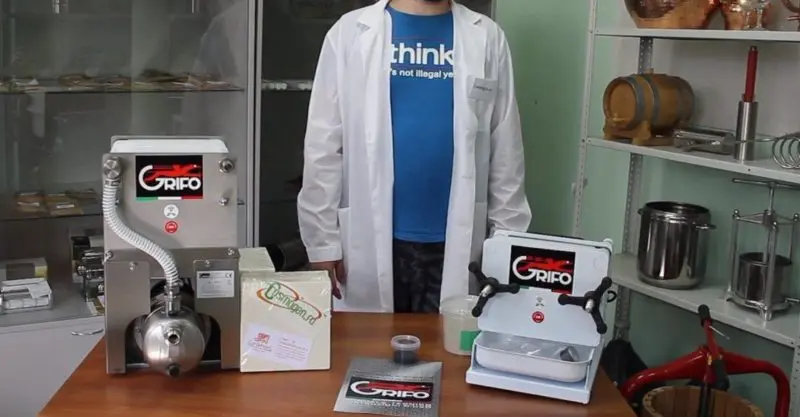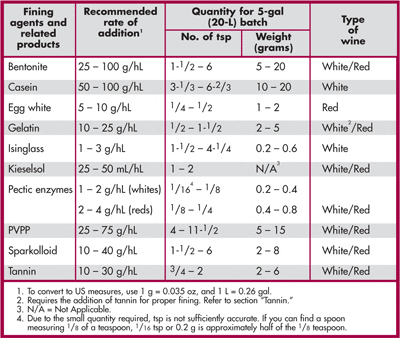Contents
Before bottling the wine after a long exposure, it is desirable to clarify it. For this, various substances are used: tannin, egg white, gelatin, bentonite, fish glue. This process is called “fining” the wine.
After three to six months of aging, light and strong table wines can be served at the table. If you did everything right, and the wine, after rapid fermentation, was defended in the right conditions, then the drink should lighten itself and it can be safely bottled. However, there are cases when the wine completely refuses to clarify on its own, which is especially true for white wines and some fruit and berry wines. In addition, a barely perceptible turbidity remains in a transparent-looking drink – the waste products of yeast fungi, the protein mass left over from dead yeast, cream of tartar and other impurities.

Before bottling wine, no matter what sort it is, it is desirable to clarify it, or, as professional winemakers say, to paste over. By fining is understood the addition to wine of various substances that have an adsorbing effect and contribute to the precipitation of foreign impurities. It should be noted right away that clarification (fining) and wine filtration are two different things. Wines are filtered through various filters made of paper, flannel, etc. This process greatly affects the quality of the wine, and not for the better. During filtration, the drink “exhales”, which means it becomes less durable, so fining is always a priority.
Wine clarification theory and substances used
In fact, in oenology – the science of wine – there is a whole section that studies the causes of clouding of wines and ways to combat this phenomenon. At wineries, this is treated very carefully and factors that can lead to clouding are excluded in advance. But at home, such extremes rarely reach, so you have to rely on chance and, if necessary, take drastic measures. Why radical? Yes, because both filtration and fining of wine lead to a decrease in the quality of the product – they “peel off” its taste and aroma, although not to a large extent. But filtering does much more than that.
Cream of tartar is an acidic salt that forms on the walls of a vessel during the production of wine. It consists of potassium hydrotartrate (KC4H5O6) and potassium tartrate (K2C4H4O6). It is tartar that is used for the production of tartaric acid, as well as in other areas of cooking as a baking powder.
It precipitates at low temperatures, an increase in alcohol content and as a result of mechanical action (shocks, mixing). When precipitated, tartaric compounds carry along yeast cells, dyes, silica, salts of iron, ammonium, and other impurities found in wine.
Choosing a gluing agent is also not so simple. For white wines, gelatin is better, for red wines with a tart taste – chicken protein, and for sweet and not tart wines, which indicates a low content of tannins – tannin or fish glue. If the dosage is correctly calculated, then these substances form bonds with third-party impurities in the form of flakes, which subsequently precipitate.
If you add them less, then clarification will not work, and if you add more, then the wine may cloud even more. Therefore, before fining the entire batch of wine, you should conduct several samples on a small amount of it and choose the optimal proportions for yourself (and the substance that will least affect the taste and aroma).
Clarification of home wine in practice
Gelatin lightening
This is one of the best ways to get rid of haze and cause minimal damage to the product. Gelatin can also be dosed more accurately, unlike, for example, egg white. For 10 liters of wine, you need from 0,5 to 2 g of high-quality, natural gelatin. Before pasting, it must be soaked for 2-3 hours in 5-10 times the amount of cold water (you can soak for a day, you need to change the water 2-3 times). Then you need to add the same amount or a little more boiling water and mix well. The result should be a gelatin solution with a temperature of 35-40 оWith no lumps.

This is what a perfectly clarified wine should look like.
The wine must be twisted into a funnel and gradually pour in the gelatin solution in a thin stream, not forgetting to constantly stir the drink. Then the wine is poured into a vessel, which must be tightly corked and left in a cool place for 2-3 weeks until it is completely clarified. After that, it is enough to drain it from the sediment. Before using gelatin, several samples should be taken so as not to miss the amount. After 3-4 days it will become clear which sample will ultimately give the best result.
Lightening with egg white
One egg white is enough to clarify 50 liters of wine, you can take 100-2 per 3 liters. It is very important to use fresh eggs. Carefully separate the protein from the yolk and lightly beat it with a little water until foamy. Pour the resulting solution into the wine and mix it thoroughly, then install a water seal on the container and send the wine to settle for 2-3 weeks. Protein, like gelatin, binds tannins, so it is advisable to add it to white wines where tannins are not appropriate, as well as to red wines, as an intermediate purification agent.
Bentonite clarification

Bentonite
They can be clarified immediately or do it after cleaning the wine with protein or gelatin in the event that they did not give a precipitate. Bentonite is just refined clay. Sold as a fine-grained gray powder. If you have not been able to buy bentonite specifically for winemaking purposes, you can use clay cat litter. The main thing is that the clay is cleaned and disinfected.
For 1 liter of wine you need 1-3 g of bentonite. Samples should be carried out before gluing to determine the exact amount.
The process of clarification of wine with bentonite approximately looks like this:
- Bentonite in the right amount is poured with 10 times the amount of water for 10-12 hours (overnight). During this time, the clay will swell and turn into a suspension. Then you need to add the same amount of clean water to it and mix until a homogeneous, creamy mass.
- We twist the wine into a funnel and pour bentonite into the center in a thin stream, constantly stirring the drink.
- We wait 5-7 days until the sediment completely falls out and drain the crystal clear wine.
Lightening with fish glue
Fish glue, unlike gelatin and protein, does not bind tannins, which means that it is good to use it for red wine that is not tart or very sweet. For 100 liters of wine, 1,5-2 g of good catfish glue is enough. It must be soaked in cold water and changed frequently until the glue granules are completely swollen. Then you need to take a small amount of wine, heat it up and pour it on the swollen granules.
Read more about making homemade grape wine in this article.
Read also an article with a recipe for apple wine, which often needs clarification.
When the glue is completely dispersed, it must be strained through a flannel to get rid of lumps and other impurities, and then pour into the wine and mix well. After 2-3 weeks, the precipitate should fall out completely.
Tannin lightening
Tannin is an odorless substance with an astringent taste. It is sold in pharmacies in the form of a yellowish powder. It is extracted mainly from oak, but there are enough tannins in the skins, seeds and ridges of grapes. It should only be used to clarify red wines (and very sweet, non-tart fruit wines) and only for those with little or no astringency. If you were preparing wine “in white”, then tannins should not be used.

To clarify the wine, you need to take 10 g of the purest tannin and dissolve it in 1-2 liters of distilled water. The infusion should be given time to settle, then strain it through filter paper, pour into a bottle, and then use. On average, 1 teaspoons of the solution are needed for 6 liter of wine, but samples must be taken before adding it, otherwise the wine can be very spoiled.
It is not difficult to make a test: take several bottles and fill them with 0,5 liters of wine, and then add an arbitrary amount of tannin solution to each of the bottles. For example, in the first bottle 1 tsp. solution, in the second – 2, etc. After 6-7 days, you can see the result and recalculate the amount of solution for the entire batch of wine. Now the solution must be poured into the wine, mix everything well and stand for 7-10 days, after which the clarified wine can be drained from the sediment.

Sample of wine lighting in production
Lighting with milk (casein)
You can try to clarify the wine with milk. For 1 liter you need to take 1 tsp. skimmed cow’s milk, mix thoroughly and leave for a few days to precipitate. The milk should curdle and form the same flakes that were discussed at the beginning of this article.
Even after fining, the wine should be aged for at least another month.
If all the described methods did not lead to success, then, unfortunately, nothing else will help your guilt. If at the same time its taste is not affected, then invite friends over and cook mulled wine or punch from it. If the taste leaves much to be desired, then the only right decision would be to overtake it for moonshine (grape – for chacha) or, in the absence of equipment and desire, simply pour it into the sewer. But let me remind you again: any fining worsens the quality of wine, in particular, it reduces the amount of tannins, so it is better to lighten the wine by aging.
You can also resort to cryostabilization, which I wrote about in an article about homemade grape wine. In the same place, I described the conditions necessary for the correct aging of the product, observing which you will surely get a beautiful, transparent wine.











ژلاتین داخل شراب قرمز ریختم ۱۰ روز گذشته اما رنگش از قرمزی به یاسی تبدیل شده
دقیقاًهمین اتفاق برای من هم افتاده کدر باقی موند و رنگش خیلی روشن تر شده ولی تو طعم و مزه اش اثر نذاشته